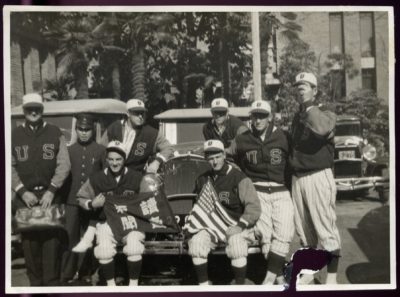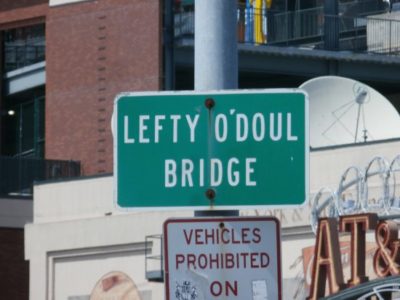Baseball History Comes Alive Now Ranked #2 by Feedspot Among All Internet Baseball History Websites and Blogs!
Guest Submissions from Our Readers Always Welcome!
Scroll Down to Read Today’s Essay
Subscribe to Baseball History Comes Alive for automatic updates. As a Free Bonus, you’ll get instant access to my Special Report: Gary’s Handy Dandy World Series Reference Guide!
Lefty O’Doul Photo Gallery
Click on any image below to see photos in full size and to start Photo Gallery:
Another Edition of…
Baseball’s Lopsided Trades:
“Lefty” O’Doul for Freddy Leach, October 29, 1928!
“Should I get credit for Joe DiMaggio? Heck, I was just smart enough to leave him alone!” –Lefty O’Doul
Ninety-four years ago this Fall, the Giants traded Lefty O’Doul to the Phillies for the aforementioned Freddy Leach. That’s right…Freddy Leach…and, no, I’ve never heard of him either!
After hitting .319 as a platoon player for the 1928 Giants and a subsequent postseason trade to the Phillies, O’Doul teamed up with Phillies’ star Chuck Klein in 1929, and the result was one of the best offensive years in baseball history. He led the National League with a .398 batting average, a record-setting 254 hits, 32 home runs, 122 RBIs, and a phenomenal 152 runs scored. His hits total broke the previous National League record of 250 set by Rogers Hornsby in 1922. The record stood until 2004 until broken by Ichiro Suzuki. O’Doul was the runner-up to Hornsby for the 1929 MVP award.
After batting .383 with 22 homers during the 1930 season, O’Doul was traded to

the Dodgers. In 1932, he batted .368 to win another league batting title. After a slow start in 1933, O’Doul was traded back to the Giants where he rallied to hit .306 the rest of the way. He played just one more year before retiring in 1934.
Over parts of 11 seasons in the major leagues (1919-1934), O’Doul played for the Yankees, Red Sox, Giants, Phillies, and Dodgers. He hit .349 with 113 home runs, 542 RBIs, .465 on-base percentage, and .542 slugging average. His .349 career average is currently fourth all-time, behind only Ty Cobb, Rogers Hornsby, and Shoeless Joe Jackson. He has the highest batting average of any player not in the Hall of Fame. He was an All-Star (1933), and a member of the World Series champion Giants (1933). He struck out only 122 times in 3658 plate appearances, an average of one every 27 at-bats.
What’s amazing about O’Doul’s offensive output is that he started his career in 1917 as a left-handed pitcher with the PCL San Francisco Seals. He made it to the majors in 1919 and had some modest success with the Yankees and Red Sox from 1919 to 1923 as a reliever. In one notable game on July 7, 1923, he gave up 16 runs over 3 innings of relief. Fourteen of the runs came in the 6th inning, setting the major league record for most runs allowed by a reliever in one appearance (only three of the 16 were earned runs).
Following the 1923 season, O’Doul developed a sore arm. The Giants returned him to the Pacific Coast League, where he was converted to a power-hitting outfielder. In 1927 he became one of four Pacific Coast League hitters to have a 30 home runs, 30 stolen bases season. He returned to the majors as an outfielder in 1928 and enjoyed seven highly productive seasons.
Following his major league career, he began an extraordinarily successful managing career in the Pacific Coast League. From 1935 to 1951, with the Seals and several other teams, he became the most successful manager in PCL history. One of his notable accomplishments was being credited with the development the young Joe DiMaggio, He was also a vital figure in the establishment of professional baseball in Japan and was called the “Father of Japanese Baseball.” He also served as baseball’s goodwill ambassador around the world before and after World War II
His name and popularity live on in his hometown of San Francisco, where the popular restaurant and bar he founded still operates as Lefty O’Doul’s Restaurant and Cocktail Lounge on Geary Boulevard and still serves his original recipe for Bloody Marys. O’Doul was inducted into the San Francisco Bay Area Sports Hall of Fame in 1981 and the Japanese Baseball Hall of Fame in 2002. With his .349 career batting average, he is often mentioned as a possible Hall of Fame candidate But with only 11 years in the majors and his lack of longevity as a hitter, he has fallen short of the necessary votes.
Gary Livacari
Photo Credits: All from Google Search
Information: Excerpts edited from the Lefty O’Doul Wikipedia page.
Gary Livacari
Subscribe to our website, “Baseball History Comes Alive!” with over 1200 fully categorized baseball essays and photo galleries, now closing in on the one million hits mark with 830K hits and over 600 subscribers: www.baseballhistorycomesalive.com























Actually, Freddy Leach was not a bad ball player. He hit .307 over a ten-year career and, according to SABR, left the game voluntarily to become a potato farmer out of personal favor.
Thanks George…great info.
[Comment deleted].
Yep…you/ve proved to be a complete jerk and so you’re not welcome here. If you want to come back with civil discussion, I’ll let you back in. Until then, take your insulting comments and go elsewhere.
Here in Cleveland, we are all too familiar with horrible trades. The Indians sent 2 franchise cornerstone players to the Yankees in the 70’s, Graig Nettles and Chris Chambliss , along with the very good reliever Dick Tidrow, in separate trades which netted a collection of marginal players: John Ellis, Jerry Kenney, Charlie Spikes (“The Bugaloosa Bomber”), Rusty Torres, Fred Beene, Tom Buskey, Steve Kline, and Fritz Peterson. And, of course, the worst was a few years earlier, in 1960, when Cleveland sent young slugger Rocky Colavito to Detroit for the almost over-the-hill Harvey Kuenn…. and, in the same year sent Norm Cash to Detroit for career minor leaguer Steve Demeter. Fortunately, around the time they built Jacobs Field, the Dick Jacobs/John Hart administration started to get it right, trading for players like Kenny Lofton (to Houston for Ed Taubensee) and hanging on to most of their superb home-grown talent for several terrific years.
Lefty definitely belongs in Hall of Fame …Rumor has it he preferred PCL to Big Leagues because he could make more money in PCL …
Restaurant moved to Fisherman’s Wharf and is now closed …
Lefty for HOF!!!
Wonderful article about Lefty O’Doul! Even though he has not been elected into the Major League Baseball Hall of Fame yet, there could be a little hope, especially in consideration of the Gil Hodges and Buck O’Neill inductions soon. In 2013 an organization I belonged to, the Baseball Reliquary inducted him into the Shrine of the Eternals, an alternative HOF, and he’s in the Japanese Baseball Hall of Fame. But there’s no hope for Lefty O’Doul’s Restaurant. It’s closed and it’s most recent owner was busted on corruption charges.
Hey Gary,
You boast a website that can not only attract “a complete jerk” but also comments almost as long as your essays! Pays to be popular.
Not sure whether I liked your response to John or the essay better…but seriously folks, always remember Lefty O’Doul as an elite hitter. That plus, as you point out, his mentoring of the great Joe D.
George Curcio should have been in the movie “The Sting.” Love the picture. And informing us as to who the heck Freddy Leach was.
Another all time stinker of a trade: Nolan Ryan for JIm Fregosi.
Ok tell me why Francis Joseph “Lefty” O’Doul is not in the National Baseball Hall of Fame & Museum in Cooperstown?
Hey Tom…thanks for checking in. Are you related to Lefty? If so maybe I can do a follow-up post with info from you. I have an entire category: “We’re Contacted by a Relative of a Former Player.” Let me know.
Ironically. I just finished reading Dennis Snelling’s book on Lefty O’Doul. He should be in the Hall not only for his batting but for his promotion of baseball in Japan. A great emissary for MLB in the Far East. As for the worst trade I fall back on Lou Brock for Ernie Broglio. Brock is rightfully in the Hall while Broglio won only 7 games over three years with the Cubs. Ernie never told anyone he hurt his arm in the latter half of 1963 and had his ulnar nerve reset in November 1964. While in Kansas City for the MLB All-Star game in 2012 I visited the Negro Leagues Hall of Fame and spoke quite awhile there with Mr. Brock. (Long story). Lou told me he was very uptight and worried about his performance when in Chicago. That the rotating coaches as manager system caused him to think that everyone was waiting for a player to do wrong. His teammates Ernie Banks and Billy Williams were laid-back individuals while on the Cardinals the atmosphere was different with Bob Gibson and Bill White highly competitive and encouraging and Manager Johnny Keane and fellow Cardinals Ken Boyer and Mike Shannon telling him to just play and don’t worry about failing.
Thanks Kevin, great info. As a lifelong Cub fan, I may never get over that one. I remember the day the trade was announced. I have to be honest and say at the time, I thought it was a good deal for the Cubs!
I guess I also should say that this is a wonderful blog with great people giving great insight into baseball with Gary leading the way!
Thanks a lot Kevin… greatly appreciate the kind words!
Hello Gary,
Yes I’m related to “Lefty” O’Doul. He was my second cousin even though most people think he was my uncle. He was “like” am uncle to me. I remember him well and visited often since I lived nearby. I never saw him play, but have fond memories of Seals Stadium. Dennis Snelling’s book is the best story on O’Doul. I’d be happy to keep in touch. Thank you.